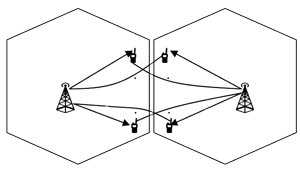Analysis of interference alignment based multi-user MIMO precoding
DOI:
https://doi.org/10.3103/S0735272721110054Keywords:
MU-MIMO, Interference Alignment, Antenna Combining, GMD, SVDAbstract
Interference mitigation for better system performance is highly significant in the modern communication systems. Rising day to day demand for wireless communication has introduced some new research efforts in terms of spectrum efficiency, maximum possible user rates, and the reuse of frequency spectrum and minimum level of interference. Interference alignment (IA) is a novel way to mitigate the inter-cell interference (ICI) of a network that leads to a better system performance. One effective technique behind this scheme is to align the interfering signal from each transmitter of neighboring cell into a predefined direction, and obtain the receive antenna combining vector of each user. With the perfect channel state information and having a feedback system with the cell base station transmitter, the IA system can increase the system sum-rate. Increasing the cell edge spectral efficiency in the cellular system is one of the prime performance factors. This paper is based on the cell edge users of a cellular communication system. Scheduling techniques for the selection of best users and antennas from large groups of users and antennas, respectively, are used in this paper. This article deals with a precoder design, with antenna and user selection techniques based on partial IA in two-cell and three-cell networks of a downlink MU-MIMO system. A comparative analysis was made on the system performance by using the singular value decomposition (SVD) based precoding and geometric mean decomposition (GMD) based precoding techniques. In this study the LTE codebook is used, which is known both to the transmitter and the receiver.
References
- V. R. Cadambe, S. A. Jafar, “Interference alignment and degrees of freedom of the K-user interference channel,” IEEE Trans. Inf. Theory, vol. 54, no. 8, pp. 3425–3441, 2008, doi: https://doi.org/10.1109/TIT.2008.926344.
- M. A. Maddah-Ali, A. S. Motahari, A. K. Khandani, “Communication over MIMO X channels: interference alignment, decomposition, and performance analysis,” IEEE Trans. Inf. Theory, vol. 54, no. 8, pp. 3457–3470, 2008, doi: https://doi.org/10.1109/TIT.2008.926460.
- Y. Fadlallah, P. Ferrand, L. S. Cardoso, J.-M. Gorce, “Interference alignment for downlink cellular networks: joint scheduling and precoding,” in 2016 IEEE 17th International Workshop on Signal Processing Advances in Wireless Communications (SPAWC), 2016, vol. 2016-Augus, pp. 1–5, doi: https://doi.org/10.1109/SPAWC.2016.7536752.
- T. Liu, C. Yang, “On the degrees of freedom of asymmetric MIMO interference broadcast channels,” in 2014 IEEE International Conference on Communications (ICC), 2014, pp. 1971–1976, doi: https://doi.org/10.1109/ICC.2014.6883612.
- A. Bayesteh, A. Mobasher, Y. Jia, “Downlink multi-user interference alignment in two-cell scenario,” in 2011 12th Canadian Workshop on Information Theory, 2011, pp. 182–185, doi: https://doi.org/10.1109/CWIT.2011.5872152.
- R. Heath, D. Love, B. Rao, V. Lau, D. Gesbert, M. Andrews, “Exploiting limited feedback in tomorrow’s wireless communication networks,” IEEE J. Sel. Areas Commun., vol. 26, no. 8, pp. 1337–1340, 2008, doi: https://doi.org/10.1109/JSAC.2008.081001.
- J. Thukral, H. Bolcskei, “Interference alignment with limited feedback,” in 2009 IEEE International Symposium on Information Theory, 2009, pp. 1759–1763, doi: https://doi.org/10.1109/ISIT.2009.5205266.
- O. El Ayach, S. W. Peters, R. W. Heath, “The feasibility of interference alignment over measured MIMO-OFDM channels,” IEEE Trans. Veh. Technol., vol. 59, no. 9, pp. 4309–4321, 2010, doi: https://doi.org/10.1109/TVT.2010.2082005.
- Y. Zhu, Y. Ou, “Interference alignment-based precoding and user selection with limited feedback in two-cell downlink multi-user MIMO systems,” J. Eng. Sci. Technol. Rev., vol. 9, no. 2, pp. 115–120, 2016, doi: https://doi.org/10.25103/jestr.092.19.
- N. Jindal, “MIMO broadcast channels with finite-rate feedback,” IEEE Trans. Inf. Theory, vol. 52, no. 11, pp. 5045–5060, 2006, doi: https://doi.org/10.1109/TIT.2006.883550.
- T. Yoo, N. Jindal, A. Goldsmith, “Finite-rate feedback MIMO broadcast channels with a large number of users,” in 2006 IEEE International Symposium on Information Theory, 2006, pp. 1214–1218, doi: https://doi.org/10.1109/ISIT.2006.261998.
- G. Sridharan, W. Yu, “Degrees of freedom achieved using subspace alignment chains for three-cell networks,” in 2013 Asilomar Conference on Signals, Systems and Computers, 2013, pp. 1869–1874, doi: https://doi.org/10.1109/ACSSC.2013.6810627.
- C. Suh, M. Ho, D. N. C. Tse, “Downlink interference alignment,” IEEE Trans. Commun., vol. 59, no. 9, pp. 2616–2626, 2011, doi: https://doi.org/10.1109/TCOMM.2011.070511.100313.
- W. Shin, N. Lee, J.-B. Lim, C. Shin, K. Jang, “On the design of interference alignment scheme for two-cell MIMO interfering broadcast channels,” IEEE Trans. Wirel. Commun., vol. 10, no. 2, pp. 437–442, 2011, doi: https://doi.org/10.1109/TWC.2011.120810.101097.
- J. Tang, S. Lambotharan, “Interference alignment techniques for MIMO multi-cell interfering broadcast channels,” IEEE Trans. Commun., vol. 61, no. 1, pp. 164–175, 2013, doi: https://doi.org/10.1109/TCOMM.2012.100912.110644.
- S. Peng, W. Lu, L. Zhong, Z. Kong, “Spatial interference alignment relying on limited precoding matrix feedback indices,” in 2020 IEEE 91st Vehicular Technology Conference (VTC2020-Spring), 2020, vol. 2020-May, pp. 1–5, doi: https://doi.org/10.1109/VTC2020-Spring48590.2020.9129168.
- X. Chen, F.-K. Gong, G. Li, H. Ding, “Interference subspace alignment in multiple-multicast networks,” IEEE Trans. Veh. Technol., vol. 68, no. 9, pp. 8853–8865, 2019, doi: https://doi.org/10.1109/TVT.2019.2929475.
- H. Lee, I. Sohn, K. B. Lee, “Low-feedback-rate and low-complexity downlink multiuser MIMO systems,” IEEE Trans. Veh. Technol., vol. 59, no. 7, pp. 3640–3645, 2010, doi: https://doi.org/10.1109/TVT.2010.2050504.
- 3GPP, “Design and evaluation of precoder codebooks for CSI feedback. R1-103839, Ericssion, and ST-Ericsson,” 2010.


